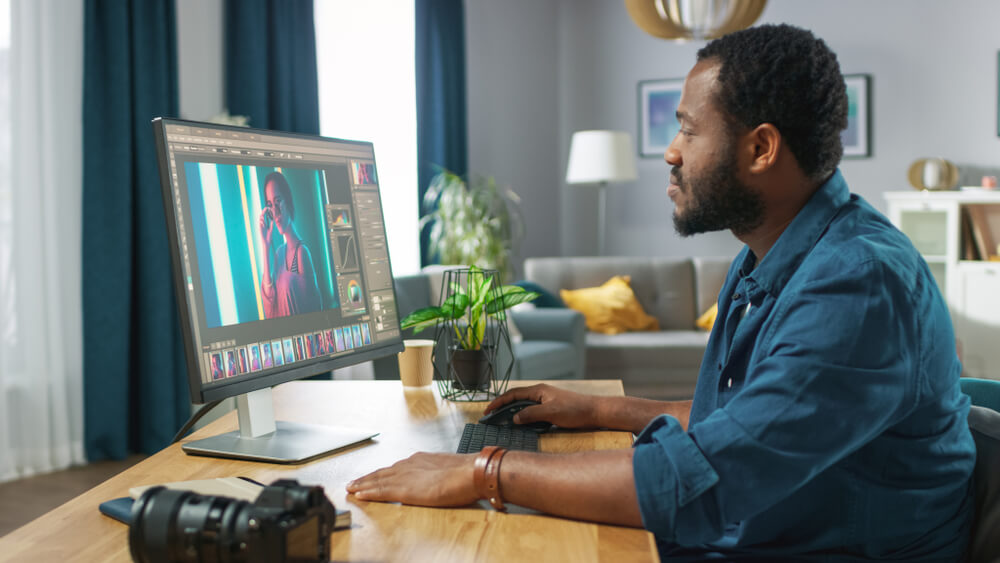What type of content do you primarily create?




Masters of time. When working with video that is what we become. In our regular day-to-day lives, we have little control overtime outside of how we’d like to spend it. When editing video, though, we can slow the passage of time, reverse it, skip the boring bits, and even freeze it. Just like gods, if gods had bad posture, deadline anxiety, and too many tabs open.
One of the most interesting ways to manipulate time in video is through time-lapse, or speeding up time. This is not only a stylish technique but can also be an extremely functional and useful storytelling tool.
Time-lapse video is a great way to add visual interest to a social media video, convey the passage of time in your latest vlog, or document the art process of your next painting. Let’s look at how to time-lapse a video as well as create a time-lapse from photos.
What is a time-lapse video?
A time-lapse is video captured over long periods of time and played back at a much faster rate, giving the appearance of time passing by at high speed. The effect turns people walking through a busy town square into fast-moving bullets or cars meandering down a lane into speeding rockets, while also showing the passage of time via shifting light and shadows.
How does time-lapse work?
Time-lapse video works by capturing images at a very low frame rate and then playing the images back at a faster frame rate.
One of the most common frame rates for digital video is 30 frames per second (fps). When you watch a standard 30fps video, you are watching 30 still images flutter before your eyes per second. If you recorded an hour of video at 30fps it would result in an hour-long video at normal speed.
A time-lapse video might be captured at, for example, 1 frame per second. When played back at 30 frames per second the result is a much shorter video in which the action appears to be increased. If you recorded an hour of video at 1 fps and played it back at normal speed the entire hour would pass by in just 2 minutes.
The rate at which you capture your footage or stills determines the speed of your time-lapse. Fortunately, you don’t need a special camera to achieve this. Even footage shot at normal speeds can create time-lapse videos.
How to capture a time-lapse video
To capture a time-lapse video, you can use the camera on your phone or a standalone camera. Regardless of which device you use in shooting a time-lapse, there are two main tips for getting the best results.
- Hold the camera steady. Use a tripod stand and lock it down, if possible. At the very least, set the camera on a steady surface. To achieve the best effect the camera should be free from shaking and bumps.
- Use manual focus. Avoid auto-focus or changing the focus suddenly. Changing focus from frame to frame can be jarring and unpleasant, resulting in the shot flickering in and out of blurriness.
How to create a time-lapse video on a phone
Virtually every smartphone has a camera with a time-lapse feature built-in. Better yet, the cameras in these devices are improving them year after year, with better resolution and color balance—which means the time-lapse videos you shoot on your phone will be stunning (*chef’s kiss*).
- iPhone. Simply choose time-lapse mode in an iPhone’s camera app to capture video—the phone takes care of the rest.
- Android. Most major brands of Android devices also feature a built-in time-lapse mode. Open the camera and change the video mode to time-lapse. On some devices, it may use a slightly different title. For example, on new Samsung devices, the feature will be called Hyper-Lapse mode.
How to create a time-lapse video using screen capture
You can also create a time-lapse video using screen capture on your computer or tablet. Digital artists, for example, record a screen capture of their desktop or device as they work to document their artistic process. In fact, some drawing apps for the iPad have built-in screen capture settings and turn them into a time-lapse. Some screen capture programs allow the user to choose any frame rate they like. For example, OBS Studio allows recording frame rates to be set as low as 1 frame per second.
How to create a time-lapse video on a camera
For more control over the captured image or longer, more advanced time-lapse videos, a DSLR or video camera may be the way to go. Many cameras have a time-lapse feature built-in, as well. For example, if you own a Sony camera look for the “S&Q” mode.
If your camera doesn’t appear to offer a built-in time-lapse feature, fear not. Time-lapse video is simply a series of photos so any camera is able to create a time-lapse. You can set your camera on a tripod and set it to capture 1 or 2 photos per second (or 5 or 10 photos per second—it’s up to you). Using editing software, you can stitch those photos together to create a time-lapse video. You can also use your camera to record video at a regular speed (30fps, for example) and then use editing software to speed the video up.
How to record a time-lapse using a video camera
- Find a stable surface. The camera should not move while shooting the time-lapse, otherwise, the video will be shaky and distracting for the viewer.
- Select the desired video mode or still photo mode. If your camera does not have a time-lapse mode, shoot your video at regular speed. When shooting video at regular speed, be aware that the longer you film, the larger the video file size will be so be conscious of how much storage space is available. Note that many cameras have an auto-shutoff mode on by default—turn this off, if possible, since you’ll likely be shooting for a long time.
- Set your focus and shutter speed. Set a fast shutter speed to have a crisper image. A slow shutter speed is ideal if you want to create a motion blur, or a ghost-like effect, on moving objects.
- Record your video. If shooting a video, press the record button and let it roll for long periods of time. If shooting still photos, use the interval timer function on your camera to trigger the photos. If your camera doesn’t have an interval timer function, you can purchase one that triggers your camera’s shutter at regular intervals.
- Put your video together. Once captured, send the video or photos to a computer to assemble the final video file. Instructions on how to turn a video into a time-lapse are detailed below.
How to make a time-lapse video from a video file
You can create a time-lapse video from video files or still images.
Creating a time-lapse from video
If the video file was shot at normal speed you can adjust the speed of the video playback with video editing software. Many video editing applications allow you to select the video clip and set the playback rate. For example, setting the clip’s speed to 1000% would play back a 30-minute recording in just 3 minutes. Simply increase the speed of the video to play as quickly as you need.
Creating a time-lapse from photos
To assemble a time-lapse from photos, most video editing software, like Descript, can import the images as an “image sequence”. Once in the video editor, set the sequence’s playback frame rate to 30 frames per second (or adjust the fps as needed, depending on how many individual photos you shot).
How to convert video to time-lapse using Descript
If you have a video that is ready to be sped up for time-lapse you can easily accomplish this effect with Descript’s video editor functions.
- Open the Descript application and click the +New button. Select Project to create a new project.
- In the new project, click Add new… and select File from Computer. Select the video file to import.
- The file will now appear in the Project Files folder within Descript. Drag the file to the project Timeline.
- Click on the clip within the timeline to highlight it. If you do not see the Clip Inspector options panel along the right, click on Show Clip Inspector.
- In the Clip Inspector panel, there is a Clip Speed option. This will allow you to slow down or speed up the playback of the video clip. The speed can be increased up to 30 times the original speed. Adjust the clip speed to your liking.
- When you’re ready to export, click on the File tab and select Export. Alternatively, you can click on the Share button in the upper right and select the Export tab.
- Under the File export group, select Video.
- Choose your video format options and click Export.





























%201.svg)










.jpg)
%20(1).JPG)
